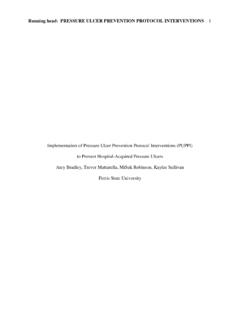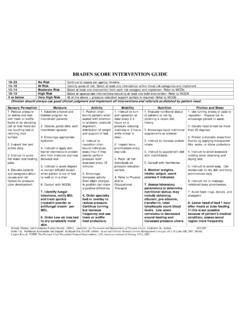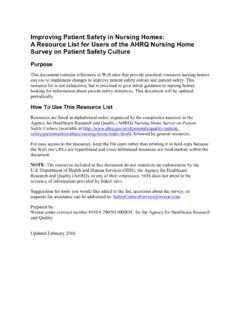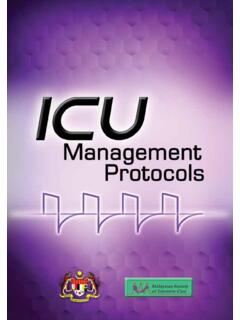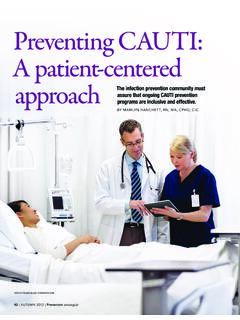Transcription of Symptom Management Guidelines: PALMAR-PLANTAR ...
1 Symptom Management Guidelines: PALMAR-PLANTAR ERYTHRODYSESTHESIA (PPE). Definition PALMAR-PLANTAR Erythrodysesthesia (PPE) is a dermatologic toxicity characterized by redness and pain on the palm of the hand and sole of the foot, and occasionally other body surfaces, also known as hand and foot syndrome (HFS). and chemotherapy-induced acral erythema Hand and foot skin reactions characterized by scaling surrounded by erythema commonly present on pressure bearing areas of the hands and feet ( finger tips, heels). Contributing Factors Chemotherapy Onset of symptoms of PPE vary with agent, dose, exposure, length of infusion and combination of 2 or more agents Chemotherapy that has microvasculature toxicity Capecitabine Pegylated liposomal doxorubicin Fluorouracil (5-FU). Sorafenib tosylate, sunitinib, lapatinib Cytarabine Docetaxel and Paclitaxel Etoposide Relevant Medical Severe renal dysfunction for drugs metabolized/excreted through the kidneys ( History fluorouracil, capecitabine, cytarabine).
2 Severe hepatic dysfunction (elevated bilirubin, AST or alkaline phosphatase) for drugs metabolized/excreted through the liver ( pegylated liposomal doxorubicin, fluorouracil, cytarabine, docetaxel, lapatinib). Previous dermatological conditions ( seborrheic dermatitis, actinic keratoses). Other Advanced age (over 65 years) and female gender more common with infusional fluorouracil Ethnicity non-white populations may have higher incidence & develop symptoms differently Alcoholism Increased body temperature ( hot baths or showers, exercise, fever, weather, climate). Increased blood flow Friction or pressure to areas of the body caused by use or by obesity ( behind the knees, groin, below the breast and axillae). Manual labour or vigorous exercise may exacerbate PPE (especially to hands and feet). Misalignment of joints Consequences Increased risk of altered skin integrity, infection Limited use of a potentially effective therapy for cancer Quality of life pain, physical and/or psychological distress, sleep-wake disturbance, impaired mobility, altered role function The information contained in these documents is a statement of consensus of BC Cancer Agency professionals regarding their views of currently accepted approaches to treatment.
3 Any clinician seeking to apply or consult these documents is expected to use independent medical judgement in the context of individual clinical circumstances to determine any patient's care or treatment. Use of these documents is at your own risk and is subject to BC Cancer Agency's terms of use, available at Page 1 of 5. Focused Health Assessment GENERAL Symptom ASSESSMENT PHYSICAL ASSESSMENT. ASSESSMENT. Contact & General Normal Vital Signs Information Refer to pretreatment nursing or oncology assessment Frequency as clinically Physician name indicated oncologist, family Onset physician When did changes start? Skin Assessment Pharmacy How are changes progressing? Ensure adequate light Home health care source and gloves if Other health care Provoking / Palliating handling non-intact skin providers What makes the symptoms better?
4 Worse? Assess all aspect of hands Allergies and feet, areas of Quality cutaneous Consider Contributing pressure/friction and What symptoms do you have? Tingling, burning, pain, Factors intertriginous areas blistering, ulceration, erythema, dryness, Cancer diagnosis and Color desquamation, cracking of skin, edema, white scaling, treatment(s) note type Degree of erythema . bullous lesions? patchy or uniformly and date of last When did symptoms begin in relation to last treatment deeply red and any chemotherapy treatment? signs of pallor in areas Medical history Can you describe the nature of the Symptom ? of intense erythema. Pre-existing skin Hyper-pigmentation in conditions (fungal Region / Radiation non-white patients disease, hyperkeratosis, Where are the changes happening? Tops of hands, eczema) fingers/fingertips, palms, soles of feet, tops of feet, Thickening Medication profile bra-line, waistline, intertriginous areas (two skin areas Hyperkeratosis of Recent lab or diagnostic that may touch or rub together) soles of feet and reports palmar surfaces Severity / Other Symptoms How bothersome is this to you?
5 (0-10 scale, with 0 not Moisture at all 10 being worst imaginable) Any accumulation of Have you been experiencing any other symptoms: fluid under skin Fever? - possible infection Discharge from blisters? possible infection Integrity Persistent bleeding? possible thrombocytopenia Any presence and size of flaking, peeling, Treatment rash, ulcers and /or Strategies used to avoid irritants, heat, and blisters mechanical irritation? Using any creams or ointments? If so, what type? Desquamation Effective? Any associated Using any pain medications? If so, what type (topical, bleeding systemic)? Effective? Any other medications or treatments? ( Vitamin B6) Swelling Degree of swelling Understanding / Impact on You Are these symptoms affecting your ability to use your Sensory changes hands or feet or performs ADLs? Tingling, numbness, pain, pruritus or Value burning What is your comfort goal or acceptable level for this Symptom (0 10 scale)?
6 The information contained in these documents is a statement of consensus of BC Cancer Agency professionals regarding their views of currently accepted approaches to treatment. Any clinician seeking to apply or consult these documents is expected to use independent medical judgement in the context of individual clinical circumstances to determine any patient's care or treatment. Use of these documents is at your own risk and is subject to BC Cancer Agency's terms of use, available at Page 2 of 5. PALMAR PLANTAR ERYTHRODYSESTHESIA GRADING SCALE*. NCI Common Terminology Criteria for Adverse Events (Version ). GRADE 1 GRADE 2 GRADE 3 GRADE 4 GRADE 5. (Mild) (Moderate) (Severe) (Life - threatening). Minimal skin Skin changes ( , Severe skin changes changes or peeling, blisters, (peeling , blisters dermatitis ( , bleeding, edema, or bleeding, edema or __ __.)))
7 Erythema, edema, or hyperkeratosis) with hyperkeratosis) with hyperkeratosis) pain; limiting pain; limiting self-care without pain instrumental ADL ADLs ( preparing meals, ( bathing, dressing, shopping) feeding self, using the toilet, taking medications). *A semi-colon indicates or' within the description of the grade and a single dash (-) indicates a grade is not available *Step-Up Approach to Symptom Management : interventions Should Be Based On Current Grade Level and Include Lower Level Grade interventions As Appropriate GRADE 1. NON URGENT: prevention , support, teaching & follow-up care as required Patient Care and Screen for skin changes at first visit; re-assess at each visit and at peak times for onset Assessment Only known cure for PPE related to chemotherapy is dose reduction or interruption Timing of onset, appearance, distribution and skin changes varies with each chemotherapy Patient Self-assessment: Assess skin daily.
8 Notify oncologist at next scheduled visit or earlier if symptoms worsen Assess for early signs of PPE including: Tingling and/or numbness (often first sign). Dry, furrowed skin that becomes reddened or darker (in non-white patients). Painless swelling or tenderness on the palms of the hands, pads of the fingers, soles of the feet and behind the knees, groin, axilla and below the breast Skin Care and Skin Care and Hygiene: Hygiene Clean hands, feet, and skin fold areas with lukewarm water; gently pat dry Wash sweat from skin Avoid hot water ( while bathing, cleaning dishes). Apply emollient creams or lotions with lanolin to keep skin hydrated ( Bag Balm , Udderly Smooth ). Apply on intact skin-liberally, gently, and often. Use keratolytics (urea & salicylic acid) to remove overgrown skin Avoid sun exposure during treatment- use sun block Avoid loose- fitting sandals or going bare feet outdoors Prevent Constriction of Skin: Tight-fitting clothes, shoes, socks, belts and jewelry as well as harsh fabrics Tight bandages, dressings or adhesive tape to skin Avoid Abrasive Conditions and Mechanical Stress: Immersing hands in strong detergent, bleach or other chemicals-use non-rubberized protective gloves Using hands for activities that might cause abrasion or mechanical stress ( clapping, typing), require tight gripping ( tools, musical instruments, driving) and vigorous activities ( jogging, aerobics).
9 Leaning on bony prominences ( elbows, knees). Sit or lie on padded surfaces The information contained in these documents is a statement of consensus of BC Cancer Agency professionals regarding their views of currently accepted approaches to treatment. Any clinician seeking to apply or consult these documents is expected to use independent medical judgement in the context of individual clinical circumstances to determine any patient's care or treatment. Use of these documents is at your own risk and is subject to BC Cancer Agency's terms of use, available at Page 3 of 5. Raise legs with cushions when possible Place pillow between knees or wear pajamas if rubbing of legs occurs during sleep Gel shoe inserts for cushioning and reducing friction Regulate Temperature: Avoid situations that raise body temperature ( steam, saunas, hot baths, heating pads, vigorous exercise).
10 Do not wear rubber gloves for dishwashing as they intensify heat Dietary Management Promote adequate hydration/nutrition during treatment to help prevent skin dryness/. desquamation Recommend daily fluid intake of 8- 12 cups (unless contraindicated) to help keep skin intact Promote a well-balanced diet high in protein, vitamins B and C. Pharmacological Advise patient to avoid using topical anesthetics or diphenhydramine containing creams Management during treatment as these may exacerbate skin toxicity Patient Education Reinforce when to seek immediate medical attention: and Follow-up Temperature greater than or equal to 38 C and/or presence of redness, discharge or odor from any open areas possible infection Unable to perform ADL reflects deteriorating patient status and severity of PPE. Uncontrolled pain in hands, feet, intertriginous areas Instruct patient/family to call back if symptoms worsen or do not improve If indicated, arrange for nurse initiated telephone follow up or physician follow-up for further assessment GRADE 2.










